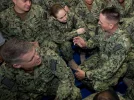John Hilly
Respected Leader
No comments...
2 killed and 13 injured in shootout within US nightclub
2 people were shot to death and at least 13 were injured in a Fort Myers nightclub in Florida. One witness stated: "It is one of the most terrifying sights." 3 suspects were arrested and the background of the incident is unclear.
2 killed and 13 injured in shootout within US nightclub
2 people were shot to death and at least 13 were injured in a Fort Myers nightclub in Florida. One witness stated: "It is one of the most terrifying sights." 3 suspects were arrested and the background of the incident is unclear.
At least 2 were killed and 13 others were injured when an armed man opened fire in a Florida nightclub. According to local media reports, 3 suspects have been arrested and the background of the incident is being checked.
The shooting incident occurred in the parking lot of Club Blu in the city of Fort Myers according to NBC. Massive Police Forces arrived on site and Rescue Forces took care of the injured. After that, they were evacuated to local hospitals. According to the Police, searches for additional suspects continue at two other locations.
According to other reports, the club was holding a youth night that also included 13-year-old kids. The incident occurred in the early morning hours in the US. One eyewitness described the scene as a "mad house." Another witness stated that they heard 30 bullets being fired.
One person stated that his friends were in the nightclub at the time of the shooting: "I called them and didn't succeed to catch them during the time of the shooting. When I arrived there, my friend told me that the shooter disappeared and the Police are chasing after him. It was crazy. People ran to every place and many called their parents. It was one of the most terrifying scenes."










